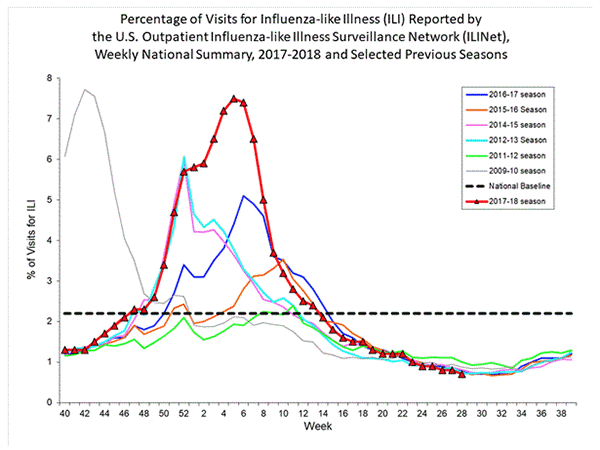In the midst of Summer, it can be difficult to think about Winter. But in terms of getting prepared for the flu season, that’s exactly what needs to happen.
It’s the Middle of the Summer, Why are We Talking About the Flu?
At this point in the year, most people are searching for the quickest way to get outside and enjoy the summer. Fall is suddenly right around the corner, and now is the time to hit the beach, lake or other getaway before the weather cools and the days get short.
For most hospitals, this period marks the slower part of the year. Census is typically lower, and it’s an opportunity to step back and determine needs for the upcoming busy season.
Yes, it feels like the 2017-18 flu season just ended. There should be plenty of time before the next flu season emerges and we see an uptick in influenza-related hospitalizations. But it’s this logic that can impact equipment availability and access for hospitals during the busy months.
High flu rates and the lack of preparedness come at a cost. The CDC reports that the average flu season costs the U.S. $10.4 billion annually in direct medical expenses. It also marks several months where hospitals find themselves short on hospital beds, critical medical equipment, and other supplies as they scramble to manage a higher influx of census. Without the right resources and a plan in place ahead of the flu season, many hospitals experience equipment shortages, a spike in equipment-related costs, and a higher burden on their clinical engineering teams.
This was the case for too many hospitals last year. Confronted with a tough flu season, a lot of health care providers were left scrambling for resources to effectively treat their patients.
The 2017-18 Season in Review:
Based on the reported flu levels from Center for Disease Control and Prevention (CDC), last season was the worst since the 2009-10 “swine flu.” In fact, the emergence of the H3N2 flu strain proved especially difficult to fight. Bolstered by a heavy flu season in Australia and the hurricanes in the Gulf that cut into the availability of I.V. bag and fluid supply, the total impact to the U.S. was significant:
- Highest rate of laboratory-confirmed influenza hospitalizations in the past 10 years with 105.4 cases per 100,000 people, ending April 28th, 2018 (CDC)
- Hospitals operated at max capacity, and in many cases exceeded capacity as well as staff and equipment shortages (Time)
- Pneumonia and influenza-related mortality rates exceeded epidemic thresholds (CDC)
 |
| *Source: CDC |
In January, the CDC estimated that flu cases had peaked between Christmas and New Years Day, but cases continued to rise throughout January and into early February. In fact, over a nine-week period during last year’s flu season, the percentage of influenza-related hospitalizations were equal to, or higher than, the highest peak in the 2016-17 season for percent of visits for influenza-like illness (ILI).
Looking ahead, influenza experts say there is a high chance of a new flu pandemic emerging in the coming years. With an inevitable flu season every year, hospitals must identify how they will meet the pending demand and avoid finding themselves under-prepared. Especially with experts indicating that, as a nation, the U.S. is less prepared today for a major outbreak than we were for the H1N1 strain.
How Hospitals Can Prepare for this Season
While we cannot predict the severity of the upcoming season, many supply chain, HTM and nursing teams are already hard at work securing and preparing the critical equipment they need for the anticipated spike in patient census.
To support their efforts, we offer five tips to consider while preparing your equipment inventory for this year’s flu season:
- Engage different stakeholders to debrief on last year’s flu season
Reach out to a cross functional team of supply chain, biomed and nursing to debrief on how your hospital weathered the flu season. Were there any equipment shortages? Were there any service backlogs? Could nurses quickly access the equipment when it was needed? Was your HTM team short staffed? Engaging multiple stakeholders across departments yields better line of sight into true equipment demand and availability, which can help inform equipment purchasing and rental decisions for the upcoming season. - Reduce equipment repair and maintenance backlogs
Staff shortages due to open positions, military leave, etc. can cause equipment like infusion pumps and ventilators to be past due on PMs or create a backlog of repair. This backlog during a flu season can result in equipment availability issues, unnecessary rental costs due to downtime, and ultimately drive nurse and patient dissatisfaction. Hospitals can mitigate challenges and unnecessary costs by reducing repair and maintenance backlogs in advance of a census spike. - Evaluate your capital purchasing strategy to save costs
During the capital planning process, most hospitals choose to purchase based on max census to ensure that they have more than enough equipment to cover for a high influx of patients (flu season). The trouble is, maintaining this inventory level comes with additional service costs and a higher burden on both the nursing and biomed teams to manage. In fact, the average utilization for a hospital is around 42% – due to a variety of breakdowns in the process. Before purchasing more equipment, conduct an inventory review, and identify common gaps between departments that prevent equipment from being readily available. You can also establish an ideal owned-to-rented equipment mix that can help you get through the busy months without spending unnecessary capital. - Secure high-use, critical rental equipment early
The flu season drives increased rental demand for respiratory equipment, hospital beds, and therapy surfaces. During a severe flu season, patient demand can outpace both providers and hospitals alike, leaving staff members to call around in search of the right device. Cut the risk and secure a longer term flexible agreement early for the critical equipment you need during the busy months. Not only can it guarantee access, but it can also reduce the wear and tear on your owned devices. - Ensure rental equipment is maintained to high-quality standards
Don’t sacrifice patient safety and regulatory compliance in the pursuit of needed medical equipment. Instead, any time you need to rent medical equipment, dive into your provider’s cleaning and maintenance process. Ensure they are ISO 13485:2016 compliant. And ask these 7 key questions about the quality of their rental equipment.
Please contact us if you would like to learn more about the steps you can take to get prepared for next flu season. This can include:
- A high-level review of your current inventory to establish an ideal rent-to-own equipment mix
- In-house biomedical repair and maintenance services
- Long-term rental agreements for high-use movable medical equipment
You can also visit our Resource Center to learn more.










